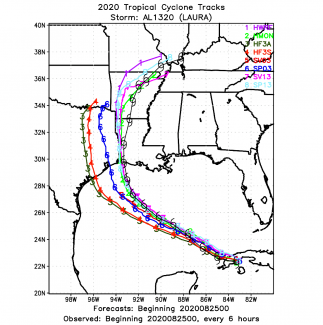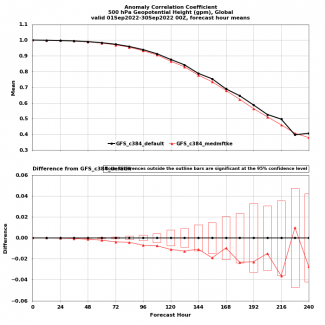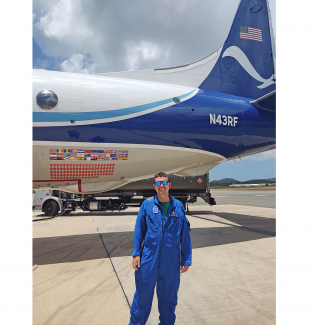One of the most important aspects of numerical modeling is the series of approximations made to represent certain physical processes, known as “parameterizations.” These approximations of critical atmospheric phenomena can make a huge impact on the solutions that a model provides, so making these parameterizations more accurate across a variety of applications is a major goal of numerical weather prediction (NWP).
One of the primary goals of this 2022 DTC Visitor Project was to examine how planetary boundary layer (PBL) physics changes affect atmospheric prediction across a variety of scales and applications, specifically on tropical cyclones (TCs) and synoptic weather. This was done through two avenues of research.
Hurricane Laura Runs
One task for this project was to examine how model physics affect TC forecast skill across a variety of scales and different Unified Forecast System (UFS) applications. The case chosen for this analysis was Hurricane Laura (2020). Two different Hurricane Analysis and Forecast System (HAFS) versions (both with 2-km grid spacing, with differing microphysics and PBL physics) exhibited a notable left bias in track (orange and green lines in Figure 1). The UFS short-range-weather (SRW) runs at 3-km grid spacing using two similar physics suites (red and blue lines) also showed a similar leftward bias. However, two SRW runs with 13-km resolution gave relatively accurate track forecasts using the same two physics suites. This indicates that the behavior of the model physics at the higher resolution might be part of the problem. This motivates us further to examine ways that model physics impact atmospheric flow at different resolutions, as explored in the next section.
GFS With Modified PBL Physics
We collaborated with Dr. Sundararman Gopalakrishnan and Dr. Xiaomin Chen to implement a modification to the turbulence kinetic energy (TKE)-based eddy-diffusivity mass-flux (EDMF-TKE) PBL physics in HAFS (known as the tc_pbl), to better represent turbulent mixing in the TC boundary layer (e.g. Chen et al. 2022, 2023, Hazelton et al. 2022). Several of these changes were based on large-eddy simulations (LES) conducted by Dr. Chen, and results showed improvement to TC structure and intensity in HAFS. We wanted to see how these changes impact large-scale atmospheric prediction. To accomplish this, we ran a month (September 2022) of forecasts of the global forecast system (GFS, which uses a physics configuration generally similar to HAFS-A), the global component of the Unified Forecast System (UFS), at 25-km resolution. Figure 2 shows the 500-hPa anomaly correlation from the default (black) and modified (red) forecasts. The modifications produce slightly lower global skill. This tells us that we need to work further to unify these changes to the PBL physics so that they improve forecast skill, not only for TC applications, but also for other worldwide prediction regimes and applications.
The DTC visitor program provided an excellent opportunity to meet and collaborate with other scientists working on various aspects of UFS, at DTC and EMC, and gain a better understanding of the types of model physics evaluation and testing being performed across a variety of scales and applications. We are especially appreciative of the guidance and support provided by DTC collaborators Brianne Nelson from NCAR, Linlin Pan from CIRES/GSL, Man Zhang from CIRES/GSL, and Evelyn Grell from CIRES/PSL in setting up this project. Kate Friedman and Mallory Row from EMC were very helpful in running the GFS and the global verification.
Ongoing and future work on this topic includes applying the modified PBL physics (tc_pbl) to the UFS SRW application to see how it impacts TC and other forecasts on both 3-km and 13-km scales in that configuration. We also plan to examine how the “scale-awareness” (adjustments for the grid size) is being handled in HAFS, and whether modifications to this adjustment can improve the model physics and TC forecasts.


